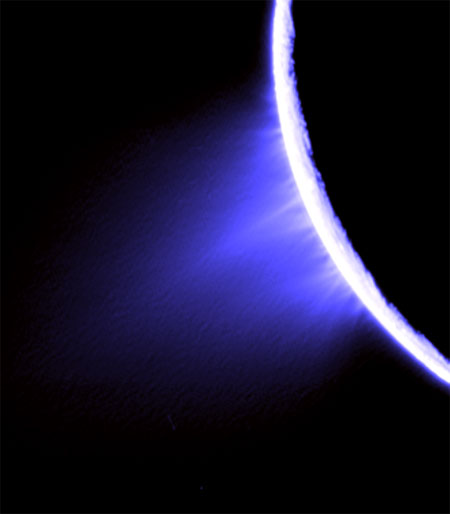Out There: Water, Water Everywhere

It's now official that water has been found on the moon, and scientists have long seen it on Mars as well. In fact, water is all over the solar system and the rest of the galaxy – and since water is key to life as we know it, these discoveries raise the hope that we are not in fact alone.
The inner planets
Although the moon remains drier than any desert on Earth, new observations from three different spacecraft have uncovered what has been called "unambiguous evidence" of water across the surface of the moon.
On Mars, giant cracks were recently found etched across crater basins that hinted at ancient lakes, and liquid water is thought to have been common across a vast region of ancient Mars billions of years ago. Craters recently even revealed that more water ice is buried closer to the red planet's equator than would be expected, "which implies there was more water in the atmosphere of Mars in the not too distant past," explained Michael Meyer, lead scientist for NASA's Mars Exploration Program.
But liquid and frozen water are not limited to Earth's closest neighbors in space.
Even hellish Venus may once have been lush with oceans. Although space probes in the 1960s found the surface of Venus was now hot enough to melt lead, images collected from the European Space Agency's Venus Express spacecraft suggest hints of past oceans. A runaway greenhouse effect – a far magnified version of the global warming seen occurring on Earth – apparently led its seas to evaporate away. "Its water, by absorbing heat, might have actually helped contribute to its greenhouse warming," Meyer said.
The outer worlds and beyond
Get the Space.com Newsletter
Breaking space news, the latest updates on rocket launches, skywatching events and more!
Most moons of the solar system's gas giants are also rich in water.
- On Saturn's moon Titan, "cryovolcanoes" are thought to erupt with cold slurries of water ice and ammonia.
- Another Saturnian moon, Enceladus, is thought to have an ocean beneath its icy shell that likely feeds jets of water ice seen spurting from that moon.
- Jupiter's moons Ganymede, Callisto and Europa, Neptune's Triton and the Uranian moons Titania and Oberon are also thought to potentially harbor hidden seas.
The outer worlds themselves are rather icy. Neptune and Uranus are often dubbed "ice giants" because they are rich with water, ammonia, and methane. Pluto is thought to consist roughly of 30 percent water ice. Beyond them lie the Kuiper Belt, Oort Cloud and the scattered disk, home to untold numbers of comets and icy dwarf planets such as Eris.
In fact, water is often found as ice or gas around stars and in the clouds between them. Signs of water have even been seen on planets outside our solar system.
What does it mean?
The fact that water is so water is abundant should not be such a surprise. "Water is ridiculously common, one of the most common molecules in the universe," said Nicolas Cowan, an astronomer and astrobiologist at the University of Washington in Seattle.
What seems rare is finding water in liquid form. In space, it either vaporizes if it is too hot or freezes if it is too cold .
"The only time you ever find it stable as a liquid is when you get enough atmosphere down to provide enough pressure to keep it liquid," Cowan explained.
Scientists looking for aliens consider liquid water "the Holy Grail, the thing that people really want to find," Cowan said. "Water is the main requirement we can see that life on Earth seems to have." Although life also needs a source of energy of some kind, in many ways, "you don't have to worry too much about that," Meyer added, since Earth shows that life can live off many different kinds of energy, from the sun or heat or chemicals.
Other life forms
Of course, alien life might not require water at all. Although it makes sense for life to require carbon, "since carbon chemistry is amazingly complex, affording one the opportunity to become complex enough to start life," Meyer explained, "you could have a liquid medium for carbon-based chemistry besides water – ammonia, for instance."
The most exciting aspect of the water that researchers are uncovering in the solar system might be how it can support humanity, not aliens.
"If we find water in sufficient quantities that it makes sense for us to use it, we can go to there and make rocket fuel out of it by separating hydrogen from oxygen, make use of resources in situ rather than shipping everything from Earth," Meyer said.
Still, don't rule out extraterrestrial life in the solar system. All the water discovered on Mars is challenging what scientists know of the red planet – enough perhaps to "dream up scenarios where the surface of Mars was a more habitable place in the distant past, with critters retreating to the subsurface to still live," Cowan noted.
- Video - Water on the Moon
- Moon Myths: The Truth About Lunar Effects on You
- Image Gallery - Full Moon Fever
Join our Space Forums to keep talking space on the latest missions, night sky and more! And if you have a news tip, correction or comment, let us know at: community@space.com.

Charles Q. Choi is a contributing writer for Space.com and Live Science. He covers all things human origins and astronomy as well as physics, animals and general science topics. Charles has a Master of Arts degree from the University of Missouri-Columbia, School of Journalism and a Bachelor of Arts degree from the University of South Florida. Charles has visited every continent on Earth, drinking rancid yak butter tea in Lhasa, snorkeling with sea lions in the Galapagos and even climbing an iceberg in Antarctica. Visit him at http://www.sciwriter.us









